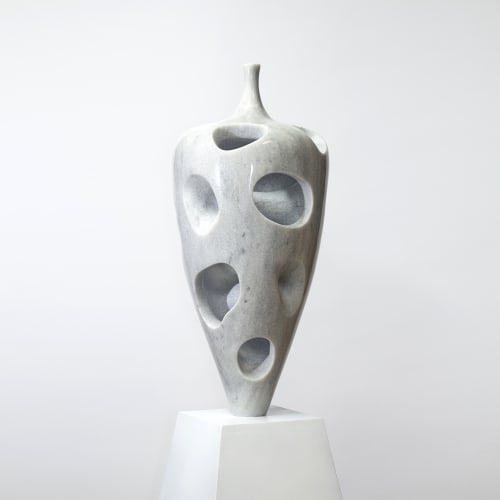Connectivity: New Explorations by Yusuké Takemura
Are we our memories?
‘Imagine you are standing at the bottom of a mountain, and you take all your memories and put them into a basket by your feet. I am at the top of the mountain also putting all my memories into a basket. Someone takes your basket and brings it up to me and empties the basket of your memories into my mind. Where do you think you exist? Are you at the bottom of the mountain now bereft of those memories or are you at the top?’ – Neurologist, Dr Jules Monatague
Contemporary sculptor Yusuké Takemura has a background in visual arts and philosophy and his work is heavily grounded in ideas of mind-body dualism, cognitive illusion, memory and connectivity. This body of work brings these ideas together in the highly technical glass sculptures Takemura is known for, as well as significant explorations in new materials including carved marble and mixed media installation.
Takemura’s glass vessels are closely related in shape to his own physical form - wide shouldered, tapering to a narrow base. The vessels are subjected to skilful cutting, grinding and polishing to remove shaped sections of glass. While the glass vessel stands as the physical entity, the voids represent the intangible mind. Takemura creates tension through his improbable structures: precarious forms that sit at the juncture of maintaining structural integrity and severing the lines of connection.
Boldly replicating his glass vessels in a large slab of solid marble, Takemura employs a similar process of cutting and grinding voids into the form. This time the tension is magnified, as marble is inflexible, vulnerable to fractures and prone to total collapse.
Acknowledging that we connect more and more through digital platforms, Takemura utilises optic fibre in a new work (as fibre optics support Cloud technology) to express connectivity. Stabilised by a server and modem, a single pane of glass is punctuated with holes and threaded with optic fibres to mirror the silhouette of a vessel. The process of construction is mindful and meditative as the location of each hole and the placement of each fibre is carefully considered. It is also laborious, as the length of the optic fibre is completely unravelled each time it is fed through a hole. The resulting mass of fibre in vessel form is gently and irregularly lit up to cast a soft glow and intersecting shadows through its twists and turns.
Takemura began experimenting with dichroic glass masks at the height of the pandemic to investigate notions of protection and disguise. The mask quickly took on historical and cultural relevance as masks are widely used in Japanese festivals and performances to conceal and reveal, exaggerate changing emotions and to mimic animal, living and spiritual forms.
Dichroic glass is a complex and chameleon-like material as it holds both transparent and reflective properties and shows, at once, its transmitted colour and opposite reflective colour.
The masks, pieced together from cuts of dichroic glass, mimic the construction of the self through snippets of experiences and memories and expound on the notion that the world is our mirror. When the mask is worn, the wearer can see their reflected facial features as well as the objects around them. As Takemura says: ‘I can observe segments of my face which are reference points to individual memories from my past as well as the world around me – these segments are pieced together and as a whole, they form my identity.’
As an extension of the masks, Takemura has created a major dichroic glass suspended work; the glass segments are again, fused together like fragmented memories that sit outside of logic or time. This scattering of memories provides a way for Takemura to look back to different moments in his lifetime, but it also acknowledges that when we remember an event from our past, our brain interferes, and it is quite likely that what we are remembering is in fact the last memory we had of the event.
Notions of visual perception and optical illusion are used by Takemura to mirror the construction of the self, the flawed nature of self-perception and to remind us that although we may largely feel that we are our memories, our memories are wholly unreliable.
Yusuké Takemura came to Australia in 2006. Having completed a Bachelor of Visual Arts at Kurashiki University of Science and the Arts, he then completed a Master of Studio Arts at the Sydney College of the Arts. Takemura currently lives and works in Canberra.
Takemura has exhibited in group and solo shows nationally and internationally, including Symbiosis, China and Australia Edge Glass Art Exhibition, China Academy of Art, China (2018), Liquid Form, Ian Potter Museum of Art, University of Melbourne, Melbourne (2018), Kaiso, Galerie Koo, Hong Kong (2017), Virtuoso II, Kirra Galleries, Victoria Australia (2017), Art16, Galerie Koo, London (2016), and SOFA Chicago, Kira Galleries, Chicago, USA (2015).
Awards and residencies include the CAPO Shaw & Partners’ Award, Canberra (2022); ArtsACT Arts Activities Award Canberra (2021); ARTSACT HOMEFRONT funding, Canberra (2020); Hindmarsh Prize, Canberra Glassworks, Canberra (Finalist, 2018); Japan Foundation New Work Grant for Arts & Culture (2014); Japan Foundation New Work, (2014); Ranamok Glass Prize (Finalist, 2014); The Vicky Torr Memorial Prize, (2011); Sabbia Gallery Exhibition Award (2011) and the 2008 NAVA Ignition Prize, Professional Practice, Australia.
Words by Rebecca Richards


